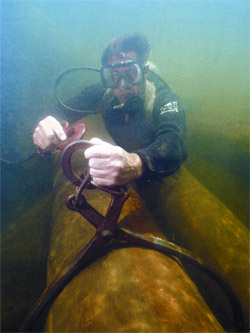More than 100 years ago, harvested trees were shipped to mills via local rivers. Today, a number of companies have taken on the task of recovering those river logs and turning them into flooring. Goodwin Heart Pine Company is located in Micanopy, Florida, where the company was founded in 1976 and is a pioneer in reclaiming wood from rivers. “Goodwin owns the federally registered trademark for the term River Recovered and we have pulled wood off southern and river bottoms for over 35 years,” said Carol Goodman, co-owner. Goodman noted that the company also produced the first engineered wood flooring product from reclaimed wood. Terry Metz, co-owner of Old-Growth Riverwood, a Wilmington, N C based company, said that recycled lumber is preferred by most contractors for a number of reasons.
“It is highly durable, attractive, low maintenance, and of course, is advantageous for the environment,” said Metz.
Eric Haglund, owner and founder of Columbia Riverwood, a Portland, Oregon based company that also recovers river wood, was founded three years ago and started out as a flooring company, but has since expanded its business, “we moved into custom furniture, countertops, etc.,” said Haglund.
Goodwin Heart Pine separates the river recovered wood by grain and color. It also teaches educational courses. “We give them terminology, grading guidelines to help differentiate different grades. Reclaimed wood, in general, is a confusing niche industry where there are no standards,” said Goodwin.
There are many different ways to identify and recover the wood underneath the water, one of which is to use divers. “Our divers are not Goodwin employees, they go into the water to feel and inspect the wood, to make sure it is worth taking out and recovering,” said Goodwin.
Metz said that Old-Growth Riverwood relies on research and sonar, which helps pinpoint the exact spot to go under the water. “We harvest the wood locally from the Cape Fear River and reclaim wood from old barns and buildings locally, regionally, and nationally. All of our wood is recycled right here in Wilmington and we even recycle the wood shavings,” said Metz.
But rivers are not the only place that companies are looking to recover wood. “Whether it is removed from an old mansion, public building or even an old industrial facility, there is a story to it that adds an unexpected value to the wood when it’s reclaimed,” said Ron Sauer, founder and president of Kingston, New York-based Excelsior Wood Products.
Excelsior doesn’t mass-produce its lumber and each floorboard is individually hand-picked and milled to the customers’ specifications. “Achieving that quality and flexibility requires a lot of specialized equipment,” said Sauer. Excelsior not only has that equipment, but has also had equipment custom built to suit his operation.
In addition to its obvious sustainable qualities, reclaimed wood is easy to take care of, according to these manufacturers. Many customers, they said, simply have the wood oiled, so it is actually much easier to maintain than other exposed flooring, which may require frequent cleaning and refinishing.
While reclaimed wood is priced higher than typical wood, manufacturers said that the benefits outweigh the cost difference. “The cost difference probably isn’t as much as many people would imagine. In some cases it’s 30% higher than everyday wood, but our customers believe it’s very much worth it. Not only do they feel that the flooring or paneling has a monetary as well as vintage quality that will quite possibly appreciate in value, but it’s an investment they can enjoy every day, that also tells a pretty good story,” Sauer said.
…………….
Reprinted with permission from Floor Covering Weekly, The Green Issue, Novermber 21/28, 2011, Reclaimed wood: Forever green, Page 17, Author, Aaron Weitzman




